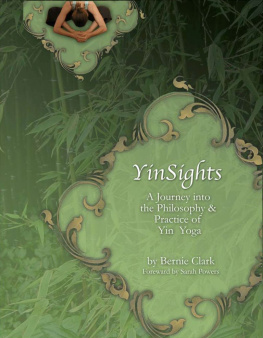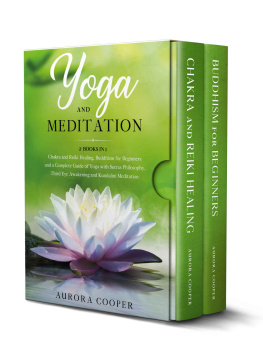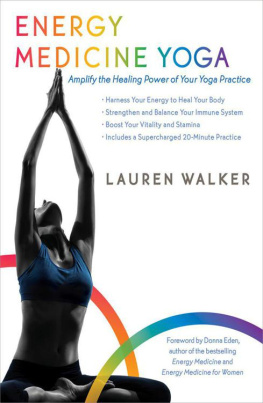
Self-Awakening Yoga
The Expansion of Consciousness
through the Bodys Own Wisdom
Don Stapleton, Ph.D.

Healing Arts Press
Rochester, Vermont
To Amba, my cherished life companion
Acknowledgments
My heartfelt gratitude:
To my family members, whose personal gifts in the lessons of love inspire me to follow my aspirations: my son, Jonathan; my parents, Joe and Mary Stapleton; my sisters, Kay Flynt and Sharon Hicks; my second family, Marilyn and Earl Henderson, Sr., Ginger, Danny and Earl, Jr.
To all my teachers, mentors and guides, especially Yogi Amrit Desai, my guru in the paradox of love; Swami Kripalu, who is the embodiment of living yoga; and Guillermo Cuellar, my first yoga teacher.
To Ann Hunt, Richard Jordan, and all of the Nosara yoga teachers, who, through your love for learning and enthusiasm for teaching, bring magic to all who take part in Nosara Yoga Institute.
To my compatriots in the Kripalu and Omega communities, for your friendship and encouragement along my journey.
To Susan Davidson, who taught me to listen for my muse, and whose creative genius for refining, collaborating, and editing has nurtured this work into fruition; to Ehud Sperling and Jon Graham, who placed their faith in me; and to the entire team at Inner Traditions, whose collective effort encourage diversity in our evolutionary vision.
To Rodrigo Oviedo Villalobos and Johann Pereira of Tierra Frtil, for your tireless creative support in producing the photos in this book as well as the technical production, music and graphic design of the accompanying CD.
To Robin and Marsha Williams, whose kindhearted support has made it possible to launch Nosara Yoga Institute as a haven for nurturing the creative spirit through yoga education.
To all who have given the generosity of your time and participation throughout my thirty years of conducting yoga classes, workshops and teacher trainingsthe gifts of your shared genius are now offered to those who hold these pages.
Prologue: Your Body as Earthen Vessel
mud \'md\ n.: wet, sticky, soft earth, as on the banks of a river
hut \'ht\ n.: a small, cozy house, shelter, or cottage
adobe \-'d-b \ n.: a sun-dried brick of clay and straw used to build a structure
MANY WISDOM TRADITIONS THROUGHOUT HISTORY CONSIDER the body to be a temple for the spirit. In order to create a conscious and functional relationship with the body, I prefer to begin with an image that is less grandiose than a temple. A temple is an awesome destination. Going to a temple requires that I leave my home and my everyday life to seek contact with the divine. There are times and places for this journey, moments in life when a pilgrimage to a place beyond home is desirable and appropriate exactly for the separation from everyday life that it affords. But I choose not to approach the body in this manner.
Rather than a temple of magnificent marble columns and lofty spires, I am inviting you into an image of your body that is more personal, more like a cozy seat in front of a hearth shared with your most trusted friend. This trusted friend beside you is yourselfnot the icon of a supreme being, not an authority on mystical transcendence, but your own inner advisor.
When my wife, Amba, and I were making plans to build a home in the jungle on the Pacific coast of Costa Rica, I attended a seminar on the contemporary uses of adobe in Central America. I grew up in the American Southwest where some of the adobe buildingsearthen structures made of clay and straw and built a thousand years agoare still standing today. Since as far back in my childhood as I can remember, being inside these adobe homes has always given me a cozy, secure feeling, like being taken into an earthen womb.
As part of the seminar we took a field trip to an ancient village in Costa Rica to see homes that have been standing for more than eight hundred years, surviving earthquakes, volcanic eruptions, and torrential storms. Passing through the portal into one of the earthen cottages, I was overcome by a vivid awareness of the many human activities that this profoundly simple home had seen. Inside the intimacy of that magical hut, where the walls reverberated with the energy of living human community, I sat down on the floor in front of a sculpted fireplace and conceived the vision of yoga that I share with you in this book.
Different from the many views present in the world of yoga today, I want to provide a perspective that comes from an inquiry into who you already are, to present a mirror for you to behold the power, beauty, and wisdom that live inside you. In my thirty years of practice in spiritual and body-based disciplines, the experiences that have made the most profound difference in my life are the ones that awaken from a place deep inside my own being.
I begin this book with the metaphor of a humble adobe hut to underscore the experience of timelessness and simplicity that we, as human beings, can have while living in our earthen, fleshly bodies. The simple beauty of a mud home is a symbol for the journey presented herein: I desire that the time you invest in the inquiry of Self-Awakening Yoga will result in a deeper appreciation for the flesh-and-blood haven of your own body. I intend nothing less than a coming home to the comfortable security of your hut, your cozy shelter within.
Yoga is often presented in the West as a way to get better. With promises of physical prowess, heavenly states of consciousness, and the attainment of powers of concentration and self-mastery, yoga is frequently undertaken with ardent hopes for a better body, stronger control of mind and emotions, and the dream of a life beyond mundane human experiences. However, embracing the technology of yogaand the authority of the yoga teachercan easily become another way of separating ourselves from our natural wisdom by encouraging us to look outside ourselves for the peace and harmony we seek. To return to our natural state of being at ease in our bodies entails a personal journey that does not require traveling beyond ourselves to find the means for expanding into our fullest evolutionary potential. To come home to ourselves calls for returning to the original creativity that permits us the freedom and benevolence of spirit to begin with ourselves as we already are.

For the many years that I taught art-education courses I made it a priority to organize a field trip early in the semester to the closest deposit of clay I could find. With forty university students caravanning to a vacant field or remote river, we would arrive amid a lot of noisedoors opening, trunks popping up, shovels and buckets clanging, and a chorus of the requisite Why are we here? questions. When I determined that I could be heard above the hubbub, a hush gave way to my pronouncement. As elementary teachers, our culture entrusts our children into your care. You have a responsibility to help children develop a comfortable relationship to nature and the world in which they live.
But Professor Stapleton, do we have to get muddy to learn how to teach this? And what about the gnats and grasshoppers out here?
I encouraged everyone to notice the discomforts as obstacles to feeling at home in these unfamiliar surroundings. How can teachers provide an experience to their students that they have not integrated within themselves? And how else can we enter into an experience of the unknown unless we are willing to pass through the initial discomforts of each moment in a new situation?
Next page









